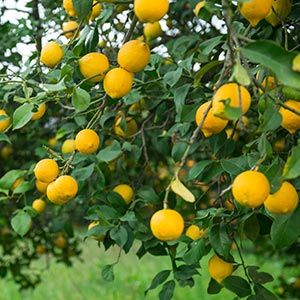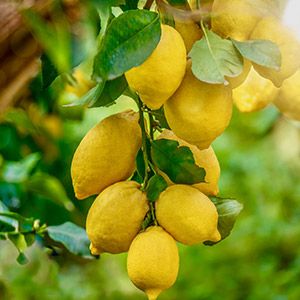Lemon: This Flavonoid-Rich Fruit Zests Up Your Pet's Palate
This yellow citrus fruit is used in many culinary creations, but did you know you can use it for your pet's meals as well? Learn how to offer it to your pet here.

STORY AT-A-GLANCE
- Lemon contains beneficial bioactive compounds such as citric acid and phenolics, as well as vitamin C, folate and potassium
- Most lemons sold today are sprayed with fungicide, so look for spray-free or organic, and wash the fruit thoroughly before using it as an ingredient in homemade food or treats
- Lemon is safe for your pet to consume if they show an interest in it, but other parts of citrus fruits, including the rind, seeds and leaves, should never be fed to pets; the rinds and other plant parts should be kept out of your pet’s reach
Editor's Note: This article is a reprint. It was originally published May 16, 2023.
When life gives you lemons, should you give some to your pet as well? It may seem like an odd thing to do, but lemons have a reputation for being rich in health-promoting properties, which may sound enticing to share with your pet. If this idea has ever crossed your mind, know that it’s safe for your dog, but there are some caveats you should be aware of.
Did You Know?

Historians believe lemon was first cultivated in South Asia. From there, it spread westward to the Mediterranean, and ancient Romans planted lemon trees as ornaments for their gardens.1
Bioactive Compounds in Lemon
The most notable bioactive compound in lemon is citric acid, as it is responsible for the fruit’s distinct sour flavor.2 Interestingly, citric acid may have health benefits, too. For example, an animal study noted that citric acid had a positive effect on brain and liver oxidative stress.3 Consuming too much citric acid can upset your pet’s stomach, though, so serving size matters if you want your pet to reap its benefits without any unwanted effects (more about how to properly serve lemon to your pets later).
Other bioactive compounds found in lemon include phenolics, such as diosmin and hesperidin.4,5 According to a study published in 2022, diosmin may have a positive benefit on IVCS (iliac vein compression syndrome) based on animal models. IVCS is a condition wherein an iliac artery compresses an overlying iliac vein, which may lead to swelling and pain in the lower extremities.6
In another mice study, diosmin helped inhibit chronic constriction injury, suggesting that this compound may help with nerve lesion-induced neuropathic pain.7 Meanwhile, hesperidin was noted to have a positive effect on neuroinflammation8 and depressive-like behaviors in mice.9
Other Beneficial Nutrients in Lemon
Being a citrus fruit, lemons are naturally high in vitamin C,10 with an ounce of juice providing 11.8 milligrams.11 Pets can synthesize vitamin C in their body, but obtaining it from their diet can also help support their optimal health. It’s needed to promote immune function and serves as a cofactor for enzymes.12 In another study, researchers noted that vitamin C may help facilitate better wound-healing13 and is important for healthy connective tissue and joints.
Lemons are also good sources of folate and potassium.14 Animals require folate for metabolic processes, such as DNA synthesis and red blood cell production.15 In another study, folic acid also helped decrease occurrences of cleft lips in pugs and chihuahuas.16 As for potassium, it’s an important electrolyte needed for proper functioning of muscles and nerves.17
Lemon Fun Fact

It is believed that all citrus fruits, including lemons, came from ancestor trees from the Himalayan foothills 8 million years ago.18
Keep These Pointers in Mind When Feeding Lemons to Pets
Misinformation about many healthy fruits, vegetables, nuts and seeds abounds on the internet. This is because websites have labeled all risks (such as the risk of overconsumption causing gastrointestinal issues, or choking on too large of pieces or pits) as "toxicities," which isn't true but has managed to confuse millions of pet lovers, nonetheless.
In the case of lemons, they contain compounds called psoralen, linalool and limonene, which may be toxic for mammals when consumed in large amounts.19 Excessive consumption of these compounds can lead to adverse effects like constipation, drooling, vomiting, diarrhea, muscle tremors or rashes in many species.20
Always feed the same parts of any fruit or vegetable you’d feed to a human toddler (only the edible parts), and cut them up into tiny pieces. Obviously, make sure to keep lemon peels, leaves and stems out of your pet’s reach. Unfortunately, most websites just say citrus fruit is toxic, which simply isn’t true.
Obviously, when using fresh lemon juice as a small component of homemade treats or pet food, you won’t be feeding the parts that make mammals sick (the leaves and rinds). The good news is lemons or lemon juice are completely safe for pets and people to consume, although pets often aren’t interested in foods that contain lemon juice because of its tartness.
You can try and encourage your dog to reap the benefits of lemon juice by sneaking 1/8 to 1/4 teaspoon of fresh juice into any homemade treat recipe you use. Add the lemon juice when you’re mixing all the ingredients together prior to baking, dehydrating or freezing the recipe.
This amazing Himalayan dog chew, also known as Chhurpi, makes use of lemon juice. Not only is it healthier than rawhide treats, but it’s inexpensive to make as well:
DIY Himalayan Chews (Chhurpi)
Ingredients:
- 1 gallon (4 liters) of skim milk
- 1/2 cup of lime juice or 1/2 cup of juice from 2 large lemons
- 1 teaspoon of salt
Procedures:
- Pour the milk in a large pot and set the stove to low-medium heat.
- Bring to a boil, stirring frequently. Turn off heat afterward.
- Slowly pour the lime/lemon juice over the milk. Add the salt.
- Stir gently for one to two minutes to encourage cheese curds to form.
- Remove cheese curds from the pot and place into a strainer.
- Gently squeeze out remaining moisture.
- Cut a desired length of fabric or cheesecloth, then place cheese curds on top.
- Fold the cloth to enclose the curds and squeeze out all remaining moisture for at least four to six hours. You can place the cheese cloth in between two plates and use a heavy weight to apply pressure. A large water jug, wine bottles or heavy books are simple ways to add weight. The more pressure you put, the harder the chew becomes.
- Remove the hardened chews from the cloth. Slice the jagged edges and discard them, then create treat-sized portions for your pet.
- Once the chews are dry, place in an oven at 150 degrees Fahrenheit (65.5 degrees Celsius) for 40 minutes.
- Remove from the oven and allow another 34 to 36 hours to dry.
Tip: If you have a dehydrator at home, you can use it instead of an oven. Set it to 150 degrees Fahrenheit (65.5 degrees Celsius) and let it run for 12 to 18 hours.
As for the actual flesh of the lemon, the chances of your pet trying it are low because of its strong odor and sour flavor. But if your pet shows an interest in lemon flesh, you can offer them a tiny piece, with the peel and seeds removed. Most pets take a lick, shake their heads vigorously in disgust, and aren’t interested in trying it again. The good news is it’s safe if they want to eat a bite. Too much fresh fruit can cause loose stools, so don’t overdo it with big quantities; too much of the fruit’s acid can also cause an upset stomach.
Top Producers of Lemon in the U.S.

California is the top producer of lemons in the U.S., accounting for 54% of total production. Second place belongs to Florida with 42%, while Texas and Arizona share the final 4%.21

Sustainability of Lemon Farming
Tests conducted by the Environmental Working Group indicate that the majority of citrus fruits sold in the U.S. are positive for fungicide residue. Imazalil and thiabendazole, both classified as endocrine disruptors, were found in the samples. These chemicals hamper your endocrine system’s ability to regulate important bodily functions.22 According to FoodPrint, lemons are also coated with wax, which is often made from petroleum or shellac, to help increase shelf life.23
Because of these findings, I recommend that you buy organic, spray-free lemons both for your and your pet’s health, whenever possible. However, if you can’t find organic lemons, you may still use commercially grown varieties. Simply wash them thoroughly to help remove as much fungicide residue as possible. Oregon State University recommends washing fruit under flowing water in a strainer, as this is more effective than dunking it in a container.24
Sources and References
- 1 Taste of History, Sep 17, 2021
- 2 Chemical Senses, Volume 43, Issue 1, January 2018, Pages 17–26, Introduction
- 3 J Med Food. 2014 May 1; 17(5): 588–598, Abstract
- 4 Antioxidants (Basel). 2022 Feb; 11(2): 239 Introduction
- 5 Plants (Basel). 2020 Jan; 9(1): 119, Abstract
- 6 Vasc Health Risk Manag. 2019; 15: 115–122, Abstract
- 7 Chemico-Biological Interactions Volume 273, 1 August 2017, Pages 180-189, Abstract
- 8 Anat Cell Biol. 2019 Dec; 52(4): 369–377, Effects of Hesperidin on Neuroinflammation
- 9 Anat Cell Biol. 2019 Dec; 52(4): 369–377, Effects of Hesperidin on Depressive-Like Behaviors
- 10,14 LiveScience, April 24, 2018
- 11 USDA, “Lemon Juice, Raw”
- 12 Free Radic Biol Med. 2011 Sep 1; 51(5): 1000–1013., Vitamin C
- 13 Int Wound J. 2016 Aug; 13(4): 572–584, Abstract
- 15 VCA Hospitals, “Folic Acid”
- 16 Pol J Vet Sci. 2013;16(1):33-7, Abstract
- 17 VCA Hospitals, “Hypokalemia”
- 18 BBC, February 8, 2018
- 19 Wag!, “What Is Lemon and Lime Poisoning?”
- 20 MasterClass, “Can Dogs Eat Lemons? 5 Symptoms if Your Dog Eats Lemons”
- 21 USDA, “Citrus Fruits 2020 Summary”
- 22 EWG, 2023 Shopper’s Guide to Pesticides in Produce
- 23 FoodPrint, “Lemons”
- 24 Oregon State University, “How Can I Was Pesticides From Fruits and Veggies?”











